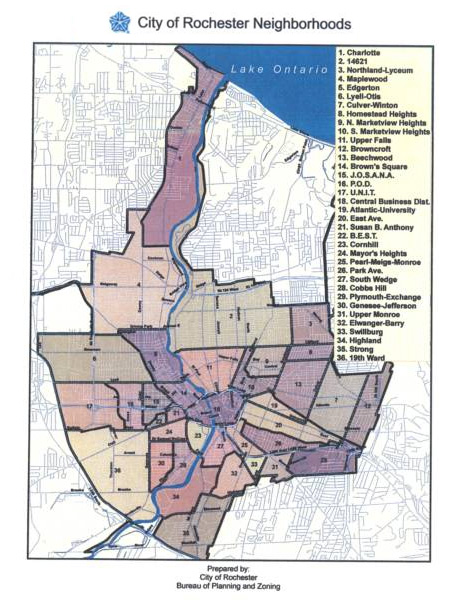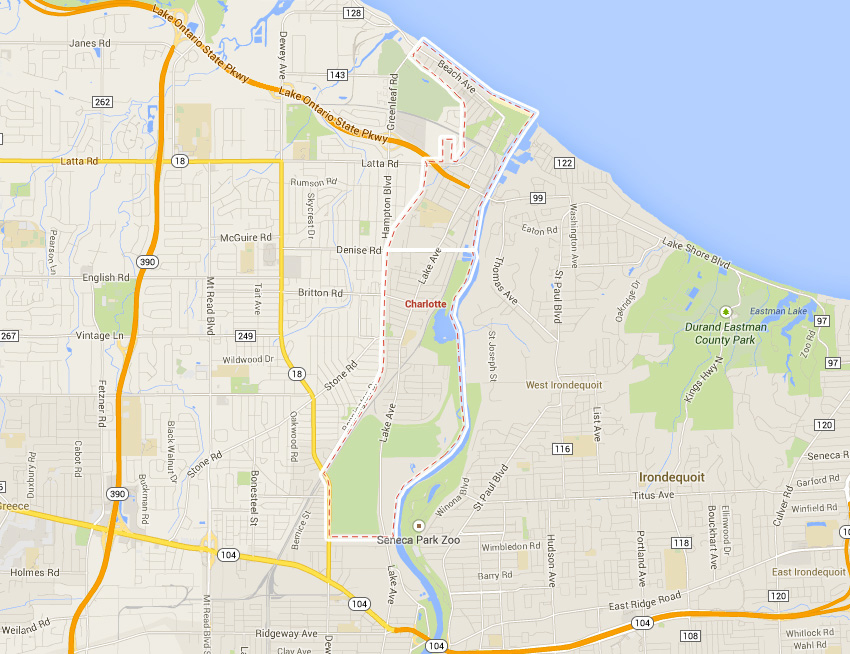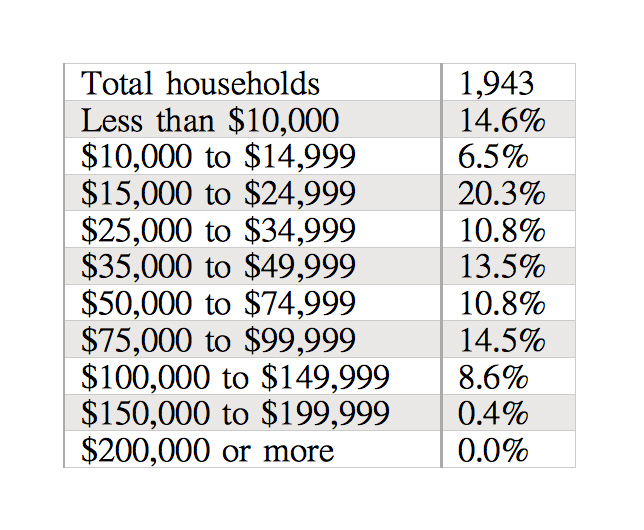This article was scraped from Rochester Subway. This is a blog about Rochester history and urbanism has not been published since 2017. The current owners are now publishing link spam which made me want to preserve this history.. The original article was published May 08, 2014 and can be found here.

The following is a guest post submitted by Matthew Denker .
Submit your story today .
In part one of our three part Charlotte bonanza, we looked briefly at the history of Charlotte, from its formation in 1792, through its resort years and annexation in the early 20th century. In part two, we'll look at Charlotte as it is today. Let's start with the lay of the land. Shown above is the official definition of the city's neighborhoods. As you know, Charlotte is the one at the top. Zooming in (and switching to Google maps) here's what we see...

The neighborhood actually comprises of two distinct census tracts. Monroe County census tract 86, which is the entire neighborhood south of Denise Road, and census tract 85, which is the entire neighborhood north of Denise Road. I'd love very much to spend additional time talking about the southern portion of Charlotte, but for the purposes of this article, and the immense focus on the waterfront, everything from here on out will be regarding census tract 85.
So physically, what's here? Well, the entire census tract is 1.07 sq miles. 0.87 square miles are land, and 0.2 are water. For reference, that translates to roughly 557 acres. If this entire land area were broken up into standard 0.1 acre city lots, it could be nearly 5,600 single family homes. At the population density of Brooklyn, it'd be home to over 30,000 people. Which brings us to our next topic. Who lives in Charlotte 1 ?
![4,162 people live in Charlotte. Over 92% of residents are white, 4% are black, and the remaining 3% are mostly mixed race or Asian. [PHOTO: Google Streetview]](https://senseofplace.dev/content/images/photos/filling-in-charlotte-rochester-ny-22.jpg)
Well, 4,162 people live here in 1,943 households. These residents are 55% female and 45% male. The median age of a resident is just under 45, and only 18% of the population is under 18. Over 92% of residents are white, while 4% are black, and the remaining 3% are mostly mixed race or Asian. Of all residents, less than 9% are Hispanic. This is significantly more white and less Hispanic than the nation (or the City of Rochester) as a whole.
Moving on to how residents work, approximately 55% of residents are in the workforce (over age 16 and employed or looking for work). Of these potential workers, 93.6% are employed and 6.4% are unemployed. Before we move on to money, here is a little bit more about the workers of Charlotte: 74% of them drive to work alone, 14% carpool, and 6% take transit. About half of the remainder walks to work and the other half work from home. The commuters have an average travel time to work of 24 minutes.
Ok, so, money. The median household income in Charlotte is $30,164. Here's a table of income at all levels:

That's right; almost no household (not even person) earns more than $150,000 a year. This will come up more in part 3, but based on the general housing affordability rule of thumb of 30% of gross income, the average household (which actually earns $43,145/yr) could afford about $13,000 a year in housing costs. This translates to being able to afford either $1,080 a month in rent, or a $140,000 house with 20% down and a 5% interest rate.
So those are the people who live in Charlotte, but in what kind of homes do all these people live? To start, there are 2,031 housing units. Just less than 100 are vacant, meaning Charlotte actually has a 96% occupancy rate. All of the vacant units are rentals. This is notably better than Rochester as a whole. As to how these units shake out, 43% are detached single family homes, while another 5% are attached single family homes. A further 18% of units are in two-family homes and 8% are in 3-4 family homes. The remaining quarter of all units is in apartments (nearly all are in Charlotte Harbortown/Lake River Homes). Less than 200 of the housing units in Charlotte have been built since 1980 and 45% were built before 1939. Size-wise, 9% of homes are studios, 21% are one-bedrooms, 29% are two-bedrooms, 32% are three-bedrooms, and the remainder are larger. Homeowners occupy 46% of the homes and renters 54% (surprise - the majority of residents are renters).
![What is in Charlotte. In a word, parking. [PHOTO: Bing Maps]](https://senseofplace.dev/content/images/photos/filling-in-charlotte-rochester-ny-23.jpg)
Alright, so we've covered who lives in Charlotte and how they live, so now let's take a look at what else is in Charlotte. In a word, parking. While there is a variety of commercial space along Lake Ave and to a lesser extent, Stutson St. Most of Charlotte is given over to our National Pastime of motoring (there is a high school, post office, some churches, a fire station, some parks, and a library, but those are a little outside the scope of what we're discussing here). The vast majority of this parking is dedicated to visiting the other major attraction in Charlotte, the beach. About 27 acres of Charlotte's 557 acres are the beach. I could write an entire article about how great the beach is (it is), but honestly, everyone reading this knows that. Let's take a look at the other part of the beach - its parking. Almost 24 acres of downtown Charlotte is given over to parking just for the beach. I'll leave it to the reader to consider the sustainability of this setup.
Going back to the rest of Charlotte, I propose an extension to part 2: I invite the readers to crowd source all of the commercial activity in Charlotte north of Denise Road. I must admit, if I were in Rochester, I would probably bike up there and do so myself, but as I am not right now, we'll need to get participatory. This inventory (which I really DO hope everyone will help out with in the comments), will also help to inform the final part of the three part series by looking at additional neighborhood amenities and how many new neighborhood residents may or may not be needed to support them.
1. All population information comes from the 2012 American Community Survey 5 year estimates . * * *
About Matthew Denker:
Matthew Denker is a Project Director by day and a fantasy real estate tycoon by night. He has a deep interest in Rochester, NY, as well as the subjects of new urbanism, walkability, mass transit, and land use. Going forward he hopes to combine all of those things to make Rochester a city competitive not only with other small, successful cities, such as Portland and Minneapolis, but even better by leveraging its easy access to the world-class cities of Toronto and New York.


